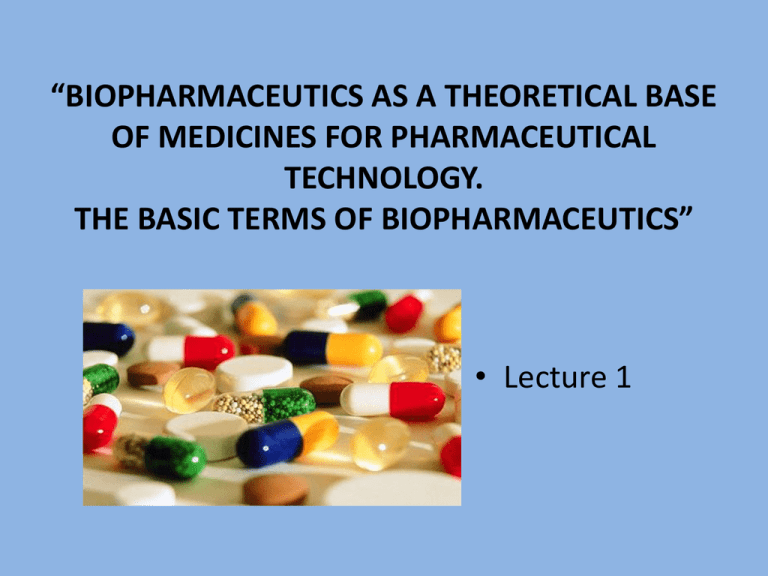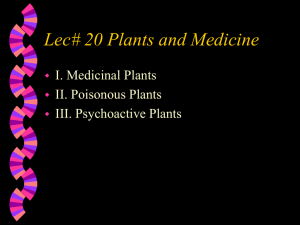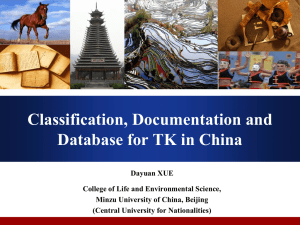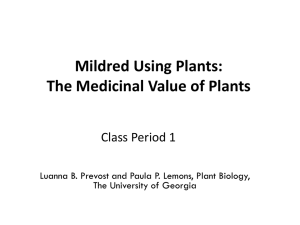
“BIOPHARMACEUTICS AS A THEORETICAL BASE
OF MEDICINES FOR PHARMACEUTICAL
TECHNOLOGY.
THE BASIC TERMS OF BIOPHARMACEUTICS”
• Lecture 1
Biopharmaceutics is a science which studies
dependence of therapeutic action of edicines on
the organism from the different variable factors.
The term
“biopharmaceutics”
appeared at first in
scientific pharmacy
of the USA in the
beginning of the 60th
years of the 20th
century and soon
got worldwide
acknowledgement.
Development of biophafraceutics
American scientists
Founders of
biopharmaceutics
Scientists
ХIХ century
The influence
of auxiliary
substances on
the processes
of absorption
of medicines
was proved
Levy and Wagner
(1961)
IBN-Sina of
Х century
Empiric supervisions about
influence of honey additions and
some vegetable medicines on the
degree of medicinal substances
action
The dependence of absorption
speed and efficiency of medicines
on the way of introduction was
defined experimentally
Factors are simultaneously working forces, conditions or other
circumstances influencing on the result of researches, data or
parameters
Factors
Constant
Medicinal substance
Dose or
concentration of
medicinal substance
Variable
Pharmaceutical
Physiological
Biochemical
Clinical
Classification of variable factors
sex
Physiologi
cal factors
age
state of organism
Pharmaceutical
factors
a physical state of the medicinal
substance
a simple chemical updating of the
medicinal substance
an auxiliary substances
(their nature, physical state and quantity)
a medicinal form and ways of application in the
organism
a technological process
Classification of variable factors
time of drug application
Clinical
factors
interaction simultaneously or
consistently entered drugs
infringements of functions: stomach, kidneys,
intimate activity, nervous system etc.
physical activity of the patient
Biochemical
factors
peculiarities of biochemical processes in
the organism and
metabolism of medicinal substances for
the given patient
Classification of variable factors
Factors
Constant
Medicinal substance
Dose or concentration of
medicinal substance
Variable
Pharmaceutical
Physiological
Biochemical
Clinical
Glossary of BiopharmaceIdutic terms
Pharmacokinetics (PK)
Pharmacodynamics (PD)
Pharmaceutical equivalent
(chemical)
Clinical
equivalent
Equivalence
Is the quantitative study of the course of drug absorption,
distribution, metabolism and elimination (ADME)
Pharmacokinetic data is very usefull in optimization of the
disage form design and establishing the dosage interval
Describes the relationship between the dose and the
pharmacological effect at the site of action
The medicine which containing identical quantity of the
substance in the same medicinal form and meeting the
requirements which are defined by the technological norms
Medicine which after application in the same dozes gives
the identical therapeutic effect which has been checked
up on any symptom or on treatment of illness
Identity of therapeutic effect of the medicine to comparison
standard medicine
The state or property of being equivalent
Equivalence
Non-equivalence
Effective substance
Efficiency
Active ingredient
is a term in pharmacokinetics used to assess the expected in vivo
biological equivalence of two proprietary preparations of a drug. If
two products are said to be bioequivalent it means that they would
be expected to be, for all intents and purposes, the same
Non equality of therapeutic action of the same medicines in
identical dozes and medicinal forms prepared by different
manufacturers or the same factory, but different series
Biologically active part of medicine taking responsibility for its
therapeutic effect
The production of the desired effects or results with minimum waste
of time, effort, or skill
That which enters into a compound, or is a component part of
any combination or mixture; an element; a constituent
Absolute
availability
Relative
availability
Dosage
Absorption
Absorption rate constant
( ka)
The quantity of the medicinal substance entered in the
medicinal form intravenously, which acts in blood
circulation without influence on the effect of the first
passage through the liver (effect «first pass»), and the
course of speed this process.
The quantity of medicinal substances in the biological
liquid, which is released from the researched medicinal
form, expressed as a Percentage, in comparison with
Absolute bioavailability or with the standard medicinal
form.
The determination and regulation of the size, frequency
and number of doses
The movement of a substance, such as a liquid or solute,
across a cell membrane by means of diffusion or
osmosis
•The constant for a drug administered by a route other than the
intravenous. The rate of absorption of a drug absorbed from its
site of application according to first-order kinetics.
•A value describing how much drug is absorbed per unit of time
Distribution
Distribution
coefficient
Reabsorption
Area under
curve (AUC)
Clearance (Cl)
The process during which the medicinal substance is
distributed from blood to the tissues and body organs
The ratio of concentrations of a substance in two
immiscible phases at equilibrium
Process of the opposite absorption of the medicinal
substance
Is the area under a plot of drug concentration vs. time.The most
common method of estimating AUC is to use the trapezoidal rule
where the concentration-time curve is considered as a series of
trapezoids and estimate the total area of all the trapezoids
Is a function of the blood flow rate (Q) to these organs. It
depends on the intrinsic ability of the organs such as the liver
and kidneys to metabolize or excrete
Absolute
availability
Relative
availability
Dosage
Absorption
Absorption rate
constant ( ka)
The quantity of the medicinal substance entered in the medicinal
form intravenously, which acts in blood circulation without influence
on the effect of the first passage through the liver (effect «first
pass»), and the course of speed this process.
The quantity of medicinal substances in the biological liquid,
which is released from the researched medicinal form,
expressed as a Percentage, in comparison with Absolute
bioavailability or with the standard medicinal form.
The determination and regulation of the size, frequency and
number of doses
The movement of a substance, such as a liquid or solute,
across a cell membrane by means of diffusion or osmosis
•The constant for a drug administered by a route other than the
intravenous. The rate of absorption of a drug absorbed from its site of
application according to first-order kinetics.
•A value describing how much drug is absorbed per unit of time
Distribution
Distribution coefficient
Reabsorption
Area under
curve (AUC)
Clearance (Cl)
The process during which the medicinal substance is
distributed from blood to the tissues and body organs
The ratio of concentrations of a substance in two
immiscible phases at equilibrium
Process of the opposite absorption of the medicinal
substance
Is the area under a plot of drug concentration vs.
time.The most common method of estimating AUC is
to use the trapezoidal rule where the concentrationtime curve is considered as a series of trapezoids and
estimate the total area of all the trapezoids
Is a function of the blood flow rate (Q) to these
organs. It depends on the intrinsic ability of the
organs such as the liver and kidneys to metabolize or
excrete
Systemic clearance
Elimination
Elimination
constant
Tolerance
Antagonism
Is the sum of all individual organ clearances that contribute
to the overall elimination of the drug. It is evaluated from
the PK data as shown in following: Cl = Dose/AUC
Is the sum of all individual organ clearances that
contribute to the overall elimination of the drug. It is
evaluated from the PK data as shown in following:
Cl = Dose/AUC
The constant rate is the process during which the effective
substance is deduced from the body by the process of
biotransformation
Tolerance to a drug develops when the response to
the same dose of the drug decreases with repeated use
Antagonism is action in which two drugs given
together will have an opposite effect on the body
Influensing of variable factors on the medical
effect of medicines
LADMER
General term characterizing the separate areas of co-operation of medicine with an
organism (Liberation, Absorption, Distribution, Metabolism, Elimination, Response),
i.e. includes biopharmaceutics, pharmaсokinetics and pharmaсodynamiсs
Therapeutic efficiency of medicines determined by processes:
•absorption (suction)
•distribution
•elimination
Many factors are responsible for the entry of a drug into the body and
then into biophase. These factors include the route of administration; the
dosage form; the liberation rate of the drug from the dosage form;
dissolution; penetration and permeation of the drug through
biomembranes; its distribution within the body fluids and tissues; the
type, amount and rate of biotransformation; and recycling processes and
elimination.
In addition to these factors, pharmacogenetics and certain
pathophysiological conditions also affect the above process.
The entire process can be described as the LADMER (liberation,
absorption, distribution, metabolism, elimination and
response) system showing that liberation, absorption,
distribution, metabolism and elimination are involved to elicit
the response. One can subdivided this approach according to
the scheme shown in fig.
. Interdisciplinary scheme of LADMER system
Rate
Liberation
- in vitro
- in vivo
Discipline
Biopharmaceutics
Absorption
Concentration
-
Distribution
-
Metabolism
-
Elimination
Response
Pharmacokinetics
Pharmacodynamics
LADMER system, biopharmaceutics hurdles in drug development,
approaches to overcome them
LADMER
Biopharmaceutic hurdle
Biopharmaceutic class
Drug
Poor Solubility
Class II
Class IV
Liberation
Chemical degradation
Approaches to
overcome the hurdle
Formulation approaches
Chemical modifications
Formulation approaches
All Classes
Chemical modifications
Enzymatic degradation
All Classes
Enzyme inhibitors
Chemical modifications
Poor Permeability
Class III
Class IV
Sorption
Absorption
promoters
Chemical
modifications
First
Distribution
Metabolism
Excretion
Response
pass
metabolism
All Classes
Alternative route
Prodrug approach
Biopharmaceutic factors affecting dissolution and/or
absorption
Physicochemical
characteristics of the
drug
Solubility
Partition
coefficient, pKa
Dissolution rate
Salt formation
Prodrugs
Particle size,
surface area and
shape
Crystallinity,
polymorphism
Stereochemical
factors
Pharmaceutical
factors
Factors related to
formulation
(excipients)
Galenical:dosage
form
Manufacturing
process
Stability and
storage of drug
and drug product
Physiological factors
affecting
bioavailability
Permeability
GI transit/motility
Site specific
absorption
Preabsorptive
metabolism
Hepatic
metabolism
Biliary excretion
Renal excretion
Protein and tissue
binding
The quantitative side of medicinal substances absorption is limited,
foremost, by efficiency (by kinetics) of their releasing on the initial stage
of absorption.
Efficiency of medicinal substances releasing is in direct dependence on
pharmaceutical factors and their successive use for advancement of
active substances by following chart:
- choice of the chemical state;
- choice of bodily condition;
- influencing of auxiliary substances;
- influencing of the simultaneously accepted medicines;
- choice of medicinal form;
- choice of way of introduction;
- establishment of exact dosage;
- influencing of pharmaceutical factors;
.
- determination of role of physiological factors enorganic this










